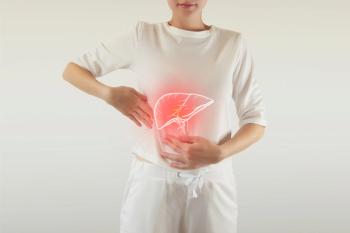
- Consultant for Pediatricians Vol 7 No 12
- Volume 7
- Issue 12
Congenital Complete Inguinal-Scrotal Hernia
This baby was born at term via spontaneous vaginal delivery. A large left-sided inguinal hernia that completely filled the scrotum was obvious at birth (A). An ultrasonogram confirmed a complete bowel-containing inguinal-scrotal hernia. No hernia was present on the right side. Both testes were descended. The scrotum is shown after the hernia was reduced by manipulation (B).
This baby was born at term via spontaneous vaginal delivery. A large left-sided inguinal hernia that completely filled the scrotum was obvious at birth (A). An ultrasonogram confirmed a complete bowel-containing inguinal-scrotal hernia. No hernia was present on the right side. Both testes were descended. The scrotum is shown after the hernia was reduced by manipulation (B).
Inguinal hernias may be noted at birth and usually present during the first year of life as a bulge in the groin.1 The bulge is often noted only intermittently during times of increased abdominal pressure, such as when the infant cries, strains to pass stool, or coughs.
Premature birth is a risk factor for inguinal hernia: the incidence is 9% to 11% in premature infants, compared with 1% to 5% in all newborns. The male-to-female ratio is 5:1; 60% of inguinal hernias are right-sided and 10% are bilateral.2
The processus vaginalis forms around 12 weeks of gestation as a peritoneal bulge through the internal ring. The testes with the accompanying processus vaginalis start descending into the scrotum by about 28 weeks of gestation. The total descent requires about 4 weeks. The layers of the processus vaginalis then fuse and degenerate, usually by the age of 2 years.3
If the processus vaginalis fails to obliterate, a peritoneal tube that is open down to the testicle remains. This sac usually contains fluid and is referred to as a communicating hydrocele. A hernia occurs when bowel enters the sac. In females, the ovary or fallopian tube may be present in the hernia.4
If the hernia does not spontaneously reduce, it is incarcerated. The herniated abdominal contents can often be returned to the abdominal cavity by gentle manipulation. Keeping the infant calm will facilitate the reduction. Reduction is accomplished by placing the thumb and index finger of one hand at the external ring, forming an inverted "V"; sustained pressure is then applied to the distal herniated bowel with the other hand (Illustration).5 The con tents of the bowel reduce first, producing a gurgling sound or sensation. Continuing pressure will then reduce the bowel.
The treatment of an inguinal hernia is surgical correction. The timing of the surgery depends on whether the hernia reduces spontaneously, requires manual reduction, or is not able to be reduced. For a hernia that reduces spontaneously, an early outpatient surgical correction can be offered; if a hernia requires manual reduction, arrange elective surgery about 48 hours after the reduction.6 A hernia that cannot be reduced requires an immediate operation to avoid vascular compromise, strangulation, and bowel necrosis. Reports have concluded that the low incidence of bilateral hernia does not justify routine exploration of the contralateral side.7
References:
1.
Kapur P, Caty MG, Glick PL. Pediatric hernias and hydroceles.
Pediatr Clin North Am.
1998;45: 773-789.
2.
Harper RG, Garcia A, Sia C. Inguinal hernia: a common problem of premature infants weighing 1,000 grams or less at birth.
Pediatrics.
1975;56: 112-115.
3.
Rowe MI, Copelson LW, Clatworthy HW. The patent processus vaginalis and the inguinal hernia.
J Pediatr Surg.
1969;4:102-107.
4.
George EK, Oudesluys-Murphy AM, Madern GC, et al. Inguinal hernias containing the uterus, fallopian tube, and ovary in premature female infants.
J Pediatr.
2000;136:696-698
5.
Clark M.
Hernia reduction.
In: Henretig FM, King C, eds. Textbook of Pediatric Emergency Procedures. Baltimore: Williams & Wilkins; 1997:927.
6.
Aiken JJ.
Inguinal hernias.
In: Behrman RE, Kliegman RM, Jenson HB, eds. Nelson Textbook of Pediatrics. 17th ed. Philadelphia: WB Saunders; 2004:1293-1297.
7.
Manoharan S, Samarakkody U, Kulkarmi M, et al. Evidence-based change of practice in the management of unilateral inguinal hernia.
J Pediatr Surg.
2005;40:1163-1166.
Articles in this issue
almost 17 years ago
Are These Pale Patches Vitiligo-or Something More Benign?almost 17 years ago
Teenaged Girl With Acute Chest Painalmost 17 years ago
Hypopigmented Patches in Infant With a History of SeizuresNewsletter
Access practical, evidence-based guidance to support better care for our youngest patients. Join our email list for the latest clinical updates.













